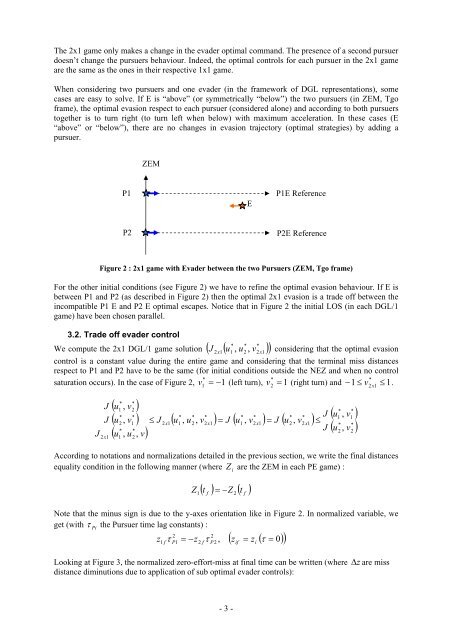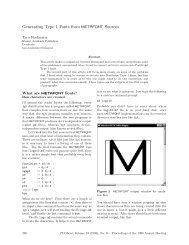Linear Differential Game With Two Pursuers and One Evader
Linear Differential Game With Two Pursuers and One Evader
Linear Differential Game With Two Pursuers and One Evader
You also want an ePaper? Increase the reach of your titles
YUMPU automatically turns print PDFs into web optimized ePapers that Google loves.
The 2x1 game only makes a change in the evader optimal comm<strong>and</strong>. The presence of a second pursuer<br />
doesn’t change the pursuers behaviour. Indeed, the optimal controls for each pursuer in the 2x1 game<br />
are the same as the ones in their respective 1x1 game.<br />
When considering two pursuers <strong>and</strong> one evader (in the framework of DGL representations), some<br />
cases are easy to solve. If E is “above” (or symmetrically “below”) the two pursuers (in ZEM, Tgo<br />
frame), the optimal evasion respect to each pursuer (considered alone) <strong>and</strong> according to both pursuers<br />
together is to turn right (to turn left when below) with maximum acceleration. In these cases (E<br />
“above” or “below”), there are no changes in evasion trajectory (optimal strategies) by adding a<br />
pursuer.<br />
ZEM<br />
P1<br />
E<br />
P1E Reference<br />
P2<br />
P2E Reference<br />
Figure 2 : 2x1 game with <strong>Evader</strong> between the two <strong>Pursuers</strong> (ZEM, Tgo frame)<br />
For the other initial conditions (see Figure 2) we have to refine the optimal evasion behaviour. If E is<br />
between P1 <strong>and</strong> P2 (as described in Figure 2) then the optimal 2x1 evasion is a trade off between the<br />
incompatible P1 E <strong>and</strong> P2 E optimal escapes. Notice that in Figure 2 the initial LOS (in each DGL/1<br />
game) have been chosen parallel.<br />
3.2. Trade off evader control<br />
* * *<br />
We compute the 2x1 DGL/1 game solution ( ( u u v<br />
)<br />
J<br />
2 x1<br />
1<br />
,<br />
2<br />
,<br />
2x1<br />
considering that the optimal evasion<br />
control is a constant value during the entire game <strong>and</strong> considering that the terminal miss distances<br />
respect to P1 <strong>and</strong> P2 have to be the same (for initial conditions outside the NEZ <strong>and</strong> when no control<br />
*<br />
*<br />
*<br />
saturation occurs). In the case of Figure 2, v = 1 (left turn), v 1 (right turn) <strong>and</strong> −1<br />
≤ v 1.<br />
J<br />
J<br />
J<br />
2x1<br />
* *<br />
( u1<br />
, v2<br />
)<br />
* *<br />
( u2<br />
, v1<br />
)<br />
* *<br />
( u , u , v)<br />
1<br />
2<br />
≤ J<br />
2x1<br />
1<br />
−<br />
2<br />
=<br />
* * *<br />
* *<br />
* *<br />
( u , u , v ) = J ( u , v ) = J ( u , v )<br />
1<br />
2<br />
2x1<br />
1<br />
2x1<br />
2<br />
2x1<br />
J<br />
≤<br />
J<br />
* *<br />
( u1<br />
, v1<br />
)<br />
* *<br />
( u , v )<br />
2<br />
2<br />
2x1<br />
≤<br />
According to notations <strong>and</strong> normalizations detailed in the previous section, we write the final distances<br />
equality condition in the following manner (where Z are the ZEM in each PE game) :<br />
( t ) = Z ( t )<br />
Z1 f<br />
−<br />
2<br />
Note that the minus sign is due to the y-axes orientation like in Figure 2. In normalized variable, we<br />
get (with τ<br />
Pi<br />
the Pursuer time lag constants) :<br />
2<br />
2<br />
z τ = −z<br />
τ , z = z τ 0<br />
i<br />
f<br />
( ( ))<br />
1 f P1<br />
2 f P2<br />
if i<br />
=<br />
Looking at Figure 3, the normalized zero-effort-miss at final time can be written (where<br />
distance diminutions due to application of sub optimal evader controls):<br />
Δz<br />
are miss<br />
- 3 -







